SECURING OUR FUTURE A
programme for government
A
B 01 SUMMARY 02 LOWER COST OF LIVING, STRONGER ECONOMY 05 HIGH QUALITY JOBS, GREENER INDUSTRY 08 21ST CENTURY SKILLS 10 MORE RESILIENT, MORE EFFICIENT 12 HEALTHY PLANET, HEALTHY PEOPLE 16 CLEAN SEAS AND RIVERS, PROTECTED WILD PLACES 19 BETTER FOOD, HEALTHIER DIETS 20 WARMER HOMES, LOWER BILLS 22 SAFER STREETS, CLEANER AIR 24 REBUILD GLOBAL LEADERSHIP 27 PROTECTING THE UK’S FUTURE IN AN UNSTABLE WORLD 28 GREEN INTERNATIONAL TRADE 30 GLOBAL LEADERSHIP ON CLIMATE AND NATURE 34 RESOURCES AND ENDNOTES CONTENTS
The government elected in 2024 will oversee the second half of a decade in which global leaders will determine whether there is a liveable planet for future generations.
Whoever forms the next government, climate and nature are likely to be high on their agenda, put there by economic necessity, public pressure and international imperatives.
The UK has made significant progress in cutting carbon emissions and, until recently, it could rightly champion that progress on the global stage. Disappointingly, the Westminster government has begun to waver on action.
OVER HALF OF VOTERS IN THE 2023 LOCAL ELECTIONS THOUGHT THE GOVERNMENT SHOULD BE DOING MORE TO TACKLE CLIMATE CHANGE.
The next government can rely on broad cross party support for environmental goals, albeit in an increasingly contested political arena, and it will be held to account by widespread public demand for action. The environment has been a top five issue for voters over the past five years. Over half of voters in the 2023 local elections thought the government should be doing more to tackle climate change.1
They see clean energy as the sector most likely to create sustainable long term growth for the economy.
Here, we set out a practical, ambitious policy programme on climate and nature for the next government.
Each recommendation is the result of research and analysis by Green Alliance, in partnership with other experts. It draws on Green Alliance’s Net zero policy tracker, which has been monitoring the delivery of climate policies since 2020. 2 The recommendations are not an exhaustive list of actions, but they should contribute to the crucial conversation ahead of the general election on what must happen during the next parliament.
This is a positive agenda for change which goes beyond addressing the climate and nature crises. It will have have significant and broad benefits for the country. Wholeheartedly pursuing this programme will be the best investment the government could make, for people, businesses and society. It underpins major priorities: building a healthy economy, cutting inflation and the cost of living, protecting the NHS, creating good jobs, supporting thriving communities and helping to secure the UK’s place in the world.
What is good for climate and nature is good for the UK.
1
SUMMARY

Lower cost of living, stronger economy

For more details on the proposals in this section, links to relevant Green Alliance outputs are available on page 32.
The UK has endured a decade and a half of stagnating productivity and flatlining real income growth. These would be daunting challenges at any time. But, in tackling them, the next government will also be faced with a sluggish economy, stubbornly high inflation, high debt and weak business investment.
The next government must adapt to the fundamental changes in the global economic system of the past decade. The climate and nature crises are driving food and energy costs. Trade operates in geopolitical blocs. Abroad, state led industrial strategies, focused on clean energy, resource security and more climate resilient food, are the dominant economic drivers.
To respond, the UK needs a major programme of green investment to transform car manufacturing, decarbonise industry, electrify power and provide incentives for the resource efficient businesses of the future. This is essential to counter decades of growth-stifling underinvestment, which has left the UK with a severely depleted capital stock that saps productivity and raises the costs of doing business. 3
THE IMPORTANCE OF THE TREASURY
HM Treasury wields considerable power over policy making in the UK, making it vital that cross governmental action effectively addresses the climate and nature crises. To date, it is yet to play its full part. The UK’s tax system, for instance, is still geared to a high carbon economy.
Decades of small scale changes that do not reflect environmental imperatives mean taxes actively hinder the transition to a low carbon, nature rich
Solving these economic problems will also help to address the high cost of living and job instability that will threaten to the popularity of the next government. It will take significant and sustained investment in each year of the next parliament to rectify them. Much of this will come from the private sector, as many businesses are keen to invest in the green economy. But substantial public investment will be needed as a kickstarter. Acting early in the parliamentary term, rather than delaying, will lock in efficiency gains and crowd in investment so the benefits accrue earlier. Underpinning this programme of renewal should be a long term green industrial strategy, to provide certaintly and act as the co-ordination point for the UK’s response to the US Inflation Reduction Act and similar international efforts.
economy by increasing the price of sustainable choices. And, as fossil fuels are phased out, the revenue from some taxes will fall, creating fiscal black holes.4
A coherent plan for the tax system is needed, with a net zero roadmap that will adjust taxes for the new economic circumstances, encouraging sustainable behaviours and maintaining a stable income for the public purse.
4
HIGH QUALITY JOBS, GREENER INDUSTRY
Our analysis shows that the UK has comparative advantage in many important green industries, including hydrogen, renewable energy and electric vehicles (EVs). As investment, regulation and technology shift towards net zero, the secure jobs of the future will be in these sectors.
The next government should exploit existing regional capabilities by building on local skills, infrastructure and knowledge. This will help to transition regional economies away from declining sectors towards new green industries, drive more skilled jobs commanding good wages and spread wealth more evenly across the country.
DEVELOPING THE GREEN INDUSTRIES AND ENERGY SOURCES OF THE FUTURE WILL BOOST THE ECONOMY AND IMPROVE ENERGY SECURITY.

BUILD THE EV SUPPLY CHAIN
The next government should use regulation, including the zero emission vehicle (ZEV) mandate, and targeted subsidies to move the UK automotive industry from fossil fuelled vehicles to EVs. Although this will be costly, doing nothing will cost far more.
The EV sector supports an estimated 800,000 jobs and generates over £70 billion in revenue. 5 Its viability is threatened by the current UK-EU Trade and Cooperation Agreement, as well as the attractive subsidies offered elsewhere, such as in the US under the Inflation Reduction Act.
The next government should focus on unlocking battery production. Total UK gigafactory capacity of 80-100GWh per year is needed by 2030 to retain current levels of UK vehicle manufacturing and avoid EU tariffs. These must sit within a wider UK battery supply chain, including processing and recycling plants, which can be achieved by addressing high energy costs for the industry and creating an attractive private investment environment, alongside direct public funding.6
5
ELECTRIFY STEELMAKING
Steel is an important and historic industry for the UK as well as a vital input for other modern manufacturing industries like wind turbines. Decarbonising the industry will protect thousands of skilled jobs.
We estimate that combined industry and government spending of £3-4 billion would fully decarbonise the UK’s two remaining blast furnace steelmaking plants, at Port Talbot (Tata Steel) and Scunthorpe (British Steel). It would also support a new hydrogen direct reduction facility for producing low carbon iron from iron ore that could be used across the industry.
Action is needed to improve scrap steel processing so scrap is of the right quality for green steelmaking in electric arc furnaces. Measures should include tax exemptions for the scrap sold in the UK, capital allowances for scrap processing machinery and minimum quality standards for exported scrap.7

DECARBONISE POWER
Converting homes, cars and industrial processes to run on electricity and using renewables to generate it will lower inflation and secure cheaper energy. This will improve the UK’s cost of living and boost industrial competitiveness.8
A clean power plan is needed to show how a decarbonised power system will be achieved. It must ensure policy is in place to deliver sufficient renewables and zero carbon flexible power, along with the supporting grid capacity and supply chains.9
To build renewables faster, the government should expand its contracts for difference (CfD) auctions, make it easier to develop onshore wind farms and direct the Bank of England to use its powers to lower interest rates for clean energy. Doing so will grow renewable sources to be 70 to 90 per cent of UK energy generation, delivered at a cheaper price and with greater security than fossil fuels.
6
To connect these new sources of electricity, the speed of grid deployment must be increased. That means speeding up planning while integrating nature and landscape impact into decision making at all stages of energy system planning and using strategic environmental impact assessment and biodiversity net gain to improve nature and climate outcomes.
Greening the power sector is a significant industrial shift essential to fully decarbonise other industries. Done correctly, it is an opportunity to lock in high quality jobs for future generations. Offshore wind creates five times as many secure jobs per megawatt of capacity than gas and around 60 per cent of the operation and maintenance jobs in the sector are highly skilled.10
BUY SECURE, ZERO CARBON POWER
The capacity market pays for the flexible sources of power needed in a high renewables future. But it is currently funnelling public money into expensive fossil fuels, mainly in the form of contracts for gas power stations.
Instead, this money should be used to build new zero carbon flexible power, reduce demand and improve demand flexibility. The next government should reform the capacity market to procure a rising share of zero carbon power and demand flexibility consistent with achieving zero carbon power no later than 2035.11
CREATE A GREEN POWER POOL
Heavy industries like steel making are major power users. High industrial electricity prices are a drain on competitiveness and a significant obstruction to decarbonising through electrification. A ‘green power pool’, as suggested by UCL, would allow energy intensive industries to access low cost renewable power at stable prices, in return for decarbonisation commitments.12
A green power pool is a centrally managed and bundled power purchase agreement. Under this arrangement the government takes on some contract risk, based on the assumption there will be multiple buyers for the same power, resulting in lower retail electricity prices for industry. In return for cheaper power, industries should commit to more flexibility in their energy use, which would lower system costs for everyone.13
7
A CLEAN POWER PLAN IS NEEDED TO SHOW HOW A DECARBONISED POWER SYSTEM WILL BE ACHIEVED.
21ST CENTURY SKILLS
A greener economy requires a ready supply of workers with the right skills. The UK will have to fill many new jobs in emerging energy technologies, as well as reskill workers in existing roles to help them take on new green tasks. The next government must strengthen the UK’s education and skills system to prepare workers for the jobs of the future. The UK has a world leading higher education sector and many excellent advanced industry apprenticeships. But the government needs to equip more workers with basic skills, and boost the number of level 2 and 3 apprenticeships in semi-skilled professions which do not require a degree or advanced training.
START FORECASTING SKILLS
Policy makers and employers cannot address shortages in skills unless they have reliable forecasts of workforce and future skills demand. Ever since the UK Commission for Employment and Skills was abolished in 2016, this information has been missing, hindering employers’ investment in the skills needed for a modern economy.
The UK needs a national body to match green skills provision with demand across industries. The government’s view of the future economy and the jobs and skills required, will be crucial to providing the necessary incentives for businesses to recognise green opportunities and the skills they need or can supply. This body could engage with local authorities and regional mayors on local skills development, and with industry on sector specific plans, such as addressing the chronic shortage of heat pump engineers.14
INTRODUCE TAX INCENTIVES FOR TRAINING AND RESKILLING
Tax breaks would provide important incentives for businesses to upskill and invest in green training. A precedent is the ‘super- deduction’ for business investment, announced in the 2021 budget. This was successful at raising investment but was withdrawn in March 2023. This tax relief was limited to physical capital, even though the UK economy is services dominated and rich in intangible assets, particularly human capital. A new successor scheme should provide 130 per cent business tax relief on green skills training.15
DEVOLVE POWER TO CREATE PLACE-BASED INDUSTRIAL STRATEGIES
In place of the confidence-destroying policy churn of recent years, the UK needs a credible, long term industrial strategy to give businesses the certainty to invest. Such a strategy should involve more place-based interventions to exploit regional strengths and legacies.16 There should be an expansion of devolution deals, giving local government, at all levels, more scope to make geographically concentrated investments in research and development, in partnership with local research institutions, catapults and universities. Better planning and more regulatory flexibility are also needed. Greater use of regulatory sandboxes – safe spaces where businesses can test new approaches – will also allow firms and investors scope to experiment with new business models.
8
THE UK NEEDS A CREDIBLE, LONG TERM INDUSTRIAL STRATEGY TO GIVE BUSINESSES THE CERTAINTY TO INVEST.

9
MORE RESILIENT, MORE EFFICIENT
Wasteful practices leave the UK vulnerable to volatile supply chains, competition for resources and higher prices. Three quarters of raw materials used in the UK are extracted abroad, and the ‘take, make, throw’ linear nature of the economy means that most of these materials are quickly lost as waste.17
The next government must focus on supporting the transition to more circular business models. This boosts productivity by keeping materials and products in use at their highest value for as long as possible, through reuse, repair, remanufacturing and recycling. A more circular economy brings many benefits, including more than 470,000 jobs by 2035, a boost to UK GDP by as much as one per cent and gross value added by as much as £82 billion.18 ,19
The critical raw materials (CRM) needed to power the low carbon transition should be a particular focus. CRM supply chains are riddled with geopolitical challenges, with China controlling over 60 per cent of some resources and the high environmental impacts of primary extraction. A successful energy transition depends on successfully managing CRM supply and demand.
CUT ENERGY DEMAND TO ENSURE SECURE SUPPLY OF CRITICAL RAW MATERIALS
As global demand for materials for the low carbon transition skyrockets, low carbon sectors in the UK could face significant supply chain vulnerabilities. To date, policies to address this have focused mainly on diversifying supply, but there is a much lower risk option. Our analysis has shown that the requirement for CRMs like cobalt and lithium could halve by 2030 compared to the current trajectory if energy demand is cut through
economy-wide measures such as insulating homes, and by increasing car sharing and public transport. Using circular economy approaches to scale up recovery and reprocessing would make it possible to meet most of the remaining demand with secondary materials by 2050. This would reduce environmental impacts while also lowering costs and protecting the economy against volatile global supply chains. 20
KICKSTART TRANSFORMATION WITH AN £800 MILLION CIRCULAR ECONOMY FUND
Businesses can make money and help customers through a range of activities that conserve resources: reuse, repair, remanufacturing and sharing. But, too often, they face barriers including embedded behaviours and structural challenges. To make these business models more mainstream, companies will need more support from the government, and from the Treasury in particular.
To date, the government has provided limited support to grow a more efficient circular economy that designs out waste. Government funding in this area has overwhelmingly focused on treating waste, including £3 billion through the Waste Infrastructure Delivery Programme. This money has done nothing to grow the innovative circular businesses of the future.
A dedicated kickstarter fund of £800 million could help to generate 100-fold returns for the economy, as it represents one per cent of the expected gross value added expected from a more circular economy. The fund should help companies that face high upfront costs as they start up or change, as well as those creating the infrastructure and logistics for circular business. 21
10
DRIVE LOWER RESOURCE USE THROUGH EMISSIONS REPORTING AND TARGETS
Emissions created in business supply chains are, on average, 11.4 times higher than direct operational emissions. When companies start measuring them, they realise how much of their carbon footprint comes from the materials, goods and services they buy. This awareness drives the use of low carbon materials and circular business practices, which often save companies money. The next government should require mandatory disclosure of value chain emissions (known as scope 3 emissions). This should begin with large listed companies and be extended to other businesses over time. 22
Alongside this, the next government should set a legally binding target to reduce emissions generated by UK demand for goods and services. These ‘consumption emissions’, which are 50 per cent higher than territorial emissions, are hidden as they are not currently covered by UK net zero legislation and are falling much more slowly. 23 Reducing them would represent real climate leadership by the UK.
TACKLE CONSTRUCTION’S HIGH CARBON AND MATERIAL FOOTPRINTS
The construction sector uses more raw material than any other in the UK, produces the most waste and is responsible for a quarter of the country’s carbon emissions on a consumption basis. 24 By adapting building and infrastructure design and adopting resource efficient techniques, it could reduce upfront resource use by 35 per cent and associated carbon emissions by 39 per cent. 25

A more circular construction industry could drive down housing costs, increase profitability and relieve supply chain pressures. 26
The next government should begin by expanding carbon assessments of new buildings to cover all embedded carbon. It should also follow the lead of the London Plan, which requires circularity statements for new developments over a certain size. This has rapidly grown a local market for circular products.
11
A CIRCULAR CONSTRUCTION INDUSTRY CAN DRIVE DOWN HOUSING COSTS, INCREASE PROFITABILITY AND RELIEVE SUPPLY CHAIN PRESSURES.
Photo by Danist Soh on Unsplash
 Photo by Dominik Pearce on Unsplash
Photo by Dominik Pearce on Unsplash
Healthy planet, healthy people

For more details on the proposals in this section, links to relevant Green Alliance outputs are available on page 34.
Protecting public health requires the next government to manage our land, waters, food, homes and transport more effectively. This is also essential to meeting the commitments in the Climate Change Act and the 2030 nature targets in the 2021 Environment Act.
Reducing carbon emissions is important for health and nature. Significant progress has been made in the power sector, but emissions remain stubbornly high in land use. Green Alliance’s Net zero policy tracker calculates that just six per cent of the necessary emissions reductions from land and agriculture are covered by confirmed policy.
Beyond land use, homes should be improved as a priority. The UK’s damp and leaky housing makes people unwell and contributes to the high cost of living. Insulating homes and heating them with clean energy will improve health, lower bills and help to insulate the country from global instability around energy supplies.
A different approach to farming and nature could improve food, diets and mental health. Using public funds to restore habitats on the least productive farmland can help to store carbon, increase wildlife and raise farm incomes, without significantly reducing food production. Eating less meat and dairy and consuming more fruit, vegetables and alternative proteins will both improve public health and increase UK food security.
Government leadership is needed to ensure this is affordable. But the rewards are high for both the NHS and individual wellbeing: four of the top five risk factors for disease and early death relate to diet, and access to nature is strongly associated with better physical and mental health. 27
14
SAFEGUARDING PUBLIC HEALTH REQUIRES A HEALTHY PLANET. AS WE LIVE WITH THE CONSEQUENCES OF THE COVID-19 PANDEMIC AND EXTREME WEATHER CONTINUES TO WREAK HAVOC, THE LINK BETWEEN HUMAN WELLBEING AND THE ENVIRONMENT IS MORE EVIDENT THAN EVER.
HOW THE UK’S ENVIRONMENT IS GOVERNED
Environmental protection in the UK is managed through a new and evolving governance system post-Brexit. In England and Northern Ireland, the independent Office for Environmental Protection oversees compliance by public authorities of environmental laws and holds the government to account on its environmental commitments. Members of the public can make direct complaints to the watchdog if they feel authorities are not respecting environmental laws.

Ministers must have due regard to a policy statement on environmental principles, which is designed to embed environmental considerations into policy making processes. A set of legally binding improvement targets cover four areas: biodiversity, air, water and waste. These are intended to drive action and are guided by interim targets in the government’s environmental improvement plan. This plan sets out activity across the breadth of the government’s environmental programme.
The Department for Environment, Food and Rural Affairs (Defra) is the lead UK government department, but environmental improvement depends on it commanding the full support of all parts of government. Two arm’s length bodies – Natural England and the Environment Agency –provide front line enforcement and advice on environmental risks such as nature recovery, water quality and waste management.
Similar systems are being established in other countries of the UK. A new governance body is in place in Scotland, called Environmental Standards Scotland. In Wales, an Interim Environmental Protection Assessor examines issues relating to the functioning of environmental law but cannot investigate or enforce specific breaches as it lacks legal powers. A new environmental governance bill has been promised by the Welsh government in the current Senedd term.
15
CLEAN SEAS AND RIVERS, PROTECTED WILD PLACES
The way nature is managed must change. Rivers are flowing with sewage, manure and fertiliser run-off that endangers the health of swimmers and wildlife. Wildfires have reached the edges of our cities. And 30 million birds have been lost from our skies in the past 50 years. The UK’s nature is feeling the strain and climate change is only going to make it worse. Along with extreme weather, these are among the most visible consequences of the climate and nature crises. Politicians are under pressure to respond quickly and effectively.
The next government needs to set out how the UK will use its land to restore nature, soak up carbon, produce food and ensure thriving rural communities.
INVEST £1 BILLION A YEAR IN NATURE RESTORATION
The UK’s least productive ten per cent of farmland produces less than one per cent of our food. Restoring woodland, wetland, rivers and other semi-natural habitats on this land would see wild bird species grow by an average of 48 per cent by 2050 and contribute two thirds of the carbon reductions required from land use in the Net Zero Strategy, without impacting food security. 28
Farmers would benefit too. Those on the least productive land tend to make a financial loss when producing food. Using this land to restore habitats instead could increase farm incomes significantly.
To help reinvigorate rural economies, the government should invest £1 billion a year to support farmers with the upfront costs of habitat creation. This investment would make it possible to meet UK nature targets, make a private market
in nature restoration viable and deliver all of the contribution required from land to the UK’s international climate commitments under the Paris Agreement. 29
PAY FARMERS FOR CLIMATE AND NATURE OUTCOMES
Farmers on poor quality land are being failed by today’s approach: upland grazing farms are set to make just £16,000 on average in 2024, which is not much more than the £15,600 they made in 2010, despite public payments just to keep farming.
Paying for services with positive environmental outcomes – like carbon sequestration, habitats for nature and flood mitigation – could potentially double the incomes of upland grazing farms. 30 Paying for these outcomes should be paired with investment in habitat creation.
CREATE A SPATIAL PLAN FOR LAND USE
The UK has committed to protect 30 per cent of its land and seas by 2030, but it is already off track to achieve this and other nature goals. 31
The government’s emerging land use framework should should map expectations of the land uses needed to achieve UK carbon, nature and food goals. In England, it should set out how the Environment Land Management scheme will support farmers to change how they use land, broadly in line with the framework. 32
A land use framework where some land is managed mainly for food production, some is managed mostly for nature and some is a mix of these two uses would enable the countryside to reach net zero carbon. It could also nearly double
16
UK wild species and would improve the incomes of the least affluent two thirds of farmers.
REINTRODUCE LOST UK SPECIES TO MEET NATURE TARGETS
In 2022, the UK celebrated its leading role in persuading governments across the globe to pledge to restore nature at the Kunming-Montreal Convention on Biological Diversity (CBD). The agreement includes a target to reduce by ten fold the risk of wild species becoming extinct by 2050.

To meet this target, England must reintroduce lost species. This includes the Kentish plover, named for the shorelines on which it has not bred since 1979, and the large copper butterfly, driven to extinction as wetlands were drained for agriculture. It also includes the burbot, a predatory freshwater fish, once so widespread it was fed to pigs but driven to extinction in 1969 as rivers became increasingly polluted.
STRENGTHEN ENVIRONMENTAL GOVERNANCE
The next government will inherit a strong environmental governance framework, but to
17
TO HELP REINVIGORATE RURAL ECONOMIES, THE GOVERNMENT SHOULD INVEST £1 BILLION A YEAR TO SUPPORT FARMERS WITH THE UPFRONT COSTS OF HABITAT CREATION.
improve outcomes this must be used and resourced effectively. The funding gap identified by the Office for Environmental Protection should be addressed to allow it to perform the role expected of it by parliament and the public.
Environmental principles must be actively used in important cross government policy tools, such as the Treasury’s Green Book and the government’s ‘Guide to making legislation’.
The next government should continue to strengthen environmental protection through new primary legislation and by using its powers in the 2021 Environment Act, not the regressive powers of the 2023 Retained EU Law (Revocation and Reform) Act.
Gaps in the legal targets framework must be addressed. This should include new targets on habitats protection, recommended by Natural England, and targets on resource efficiency.
Defra must expedite delayed policies such as the deposit return scheme and extended producer responsibility (EPR) reforms. The department’s approach to stakeholder engagement should be reset, increasing transparency and opportunities for co-designing and scrutinising policy development.
ROUTINE FLARING AND VENTING OF METHANE IN THE NORTH SEA SHOULD BE BANNED FROM 2025.
IMPLEMENT THE GLOBAL METHANE PLEDGE
Methane is a potent greenhouse gas responsible for at least of quarter of global warming. Fifty eight per cent of the UK’s methane emissions come from land uses. 33
As the 2021 COP26 climate summit host, the UK helped create the Global Methane Pledge to reduce methane emissions by 30 per cent by 2030, compared to 2020 levels. But the UK is still not doing enough to cut methane emissions.
Our analysis shows it is cost effective for the UK to cut emissions by 43 per cent. 34 At a minimum, the next government should mandate the use of methane suppressing cattle feed additives. This could cut agricultural methane emissions by nine per cent while adding less than 33p per year to the cost of milk for the average person.
Routine flaring and venting of methane in the North Sea should be banned from 2025. This would stop enough wasted gas to heat 750,000 homes. Along with measures to reduce methane leaks from oil and gas operations, the energy sector’s methane emissions could be reduced by 72 per cent.

18
BETTER FOOD, HEALTHIER DIETS
Poor diet is the biggest cause of preventable illness, placing huge strain on the NHS and condemning people to lives of long term health problems or premature death. Eating more fruit, vegetables, pulses and alternative proteins, and less meat and dairy, will improve the nation’s health, cut carbon emissions and free up more land for nature.
The task for the next government is to make healthy eating the affordable first choice for families, easing pressure on the NHS.
TAX FOODS HIGH IN FAT, SALT AND SUGAR
Unhealthy food now accounts for over half of the average UK diet. 35 The main culprit is foods high in fat, salt and sugar. These are much more profitable than healthy options, which is why a tax on high fat, salt and sugar foods makes sense. Using taxation for this purpose works: the soft drinks industry levy led to a 35 per cent reduction in sugar content without a noticeable impact on sales. 36 The case for a tax is justified by the health benefits alone, as set out in the National Food Strategy.
However, there is also an environmental benefit from reducing the consumption of junk food, because much of it contains processed meat and dairy. Diets with more plants and less red and processed meat have half the carbon footprint of the average UK diet.
COMMIT AT LEAST £250 MILLION TO DEVELOP ALTERNATIVE PROTEINS
The next government should support good quality, healthy alternatives to meat and dairy. The UK could be a world leader in the emerging
alternative proteins sector, with the right mix of investment and regulations.
Developing and manufacturing these foods in the UK means high productivity jobs in research, manufacturing and production, as well as farming jobs.
The next government should commit at least £250 million to fund two or more alternative protein research and production clusters to help the UK industry scale up and to strengthen the Food Standards Agency.37 This would enable new products to come to market more swiftly while maintaining consumer confidence, and is in line with the National Food Strategy’s call for investment.
REDUCE FOOD WASTE
The UK wastes a lot of food and, therefore, a lot of money. Households and businesses spend £19 billion on wasted food each year. 38 This has a vast carbon and nature cost, with food waste causing up to ten per cent of total man-made greenhouse gas emissions globally. 39
Food price inflation rose significantly in 2023, making it morally and politically essential to prioritise bringing food costs down. By the government’s own calculation, tackling food waste is an investment that pays for itself. A £1 business investment to reduce food waste yields £14 in return.40 A reduction in food waste over a year of just a quarter of one per cent, driven by better reporting, would save large businesses money that could then be passed on in lower costs to consumers.41
The next government should introduce the much delayed food waste reporting requirement for large businesses and prioritise the rollout of consistent food waste collections.
19
WARMER HOMES, LOWER BILLS
The cost of living crisis has been driven by skyrocketing energy bills, as gas prices spiralled following the invasion of Ukraine and as the global economy rebounded from the pandemic. They are predicted to remain high for years to come.
The pandemic showed how the government can respond quickly. The next government needs to act with the same sense of urgency to reduce energy bills further and eradicate fuel poverty long term by improving the nation’s homes, while making sure the costs of improvement are distributed fairly.
Retrofitting homes is essential to public health in a changing climate. Cold, damp and mould make existing heart and lung conditions worse and lead to avoidable hospitalisation. Health risks are also now rising in the summer months due to climate change: London experienced extreme heat on ten times as many days between 2019 and 2023 than between 1950 and 1954.42 The country’s homes need to be adapted to help people cope better with heat.

20
FUND A RETROFIT PROGRAMME TO BRING ALL HOMES TO A MINIMUM OF EPC C BY 2030
Improving a typical semi-detached home to energy performance certificate (EPC) band C could save a family up to £530 per year.43 Green Alliance’s Net zero policy tracker shows that doing this for privately rented homes by 2028 would meet six per cent of the emissions reductions needed from buildings and heating by 2032, and would keep the UK on track to meet its climate commitments.
The next government should roll-out a ten year area-based retrofit programme for all building tenures, worth at least £6 billion a year. It should ensure all domestic privately rented homes are at a minimum of EPC C by 2028, and all homes should meet the same standard by 2030.
SPEED UP HOME HEATING ELECTRIFICATION
The future of home heating is heat pumps and district heating. The path to get there includes implementing an ambitious clean heat market mechanism (CHMM) in the first year of the parliamentary term, extending the Boiler Upgrade Scheme beyond 2028 and reforming EPCs.
If a CHMM is implemented effectively and fairly, it will reduce the upfront cost of heat pumps, kickstart the supply and installation markets, and expand heat pump manufacturing in the UK.
Pairing a CHMM with an extension of the Boiler Upgrade Scheme beyond 2028 would ensure the upfront cost of a heat pump was equivalent to a gas boiler.
Reforming EPCs so heat pumps contribute positively to home efficiency ratings will help to make them the heating appliance of choice.
ZERO RATE VAT FOR BUILDING RETROFIT
The UK has some of the least energy efficient housing stock in Europe and commercial buildings suitable for conversion to residential dwellings are being torn down at an alarming rate: the commercial floor space demolished in 2018 was equivalent to 210,000 two bedroom flats. Although not all suitable for housing, much of it would have been. This is perpetuated by a tax system that rewards developers for new development, while owners of existing buildings are deterred from repairing them by unfair high costs.
No VAT is paid on new homes and buildings, but improving the energy efficiency of homes and offices, or converting them for reuse, incurs 20 per cent VAT. Energy saving products, like insulation and heat pumps, were given a temporary VAT holiday in the 2022 spring budget. This should become permanent and be expanded to other retrofitting activities that preserve or improve the environmental performance of existing buildings.44
BUILD NEW HOMES NEAR PUBLIC TRANSPORT
The UK needs more homes. Where they are built affects lifestyles, transport choices and the environment. Building new homes at higher densities near to existing public transport hubs reduces carbon emissions, improves air quality and leaves more space for nature, while reducing car dependency.
This can be achieved by strategic spatial planning that creates a long term vision for towns and cities, with net zero and nature’s recovery at its heart. It is essential to include local people in the process. Trialling the idea of ‘street votes’ is one way to achieve this.45
21
IMPROVING A TYPICAL SEMI-DETACHED HOME TO EPC BAND C COULD SAVE A FAMILY UP TO £530 PER YEAR.
SAFER STREETS, CLEANER AIR
Transport is the UK’s most polluting sector, responsible for a third of greenhouse gas emissions.46 Congestion costs the economy £8 billion a year, air pollution is responsible for at least 28,000 early deaths every year and over 97 per cent of UK addresses are subjected to air that exceeds World Health Organization pollution guidelines.47,48 With the right set of policies, the transport system could be green, accessible and affordable.
The job for the next government is to accelerate an ambitious electric vehicle rollout, make active travel and public transport easy, affordable and attractive, and align fiscal policy with these ambitions.
Improving the UK’s transport network would save the NHS money by preventing avoidable deaths and illnesses and making the air cleaner to breathe. Reducing congestion will also help to get the economy moving and improve connectivity.
REVIVE BUS SERVICES NATIONWIDE
The number of journeys taken by bus has steadily decreased over the past decade. This is the wrong trajectory for transport decarbonisation. Green Alliance focus group work shows that buses are popular, but reducing fares alone will not be enough to encourage people to use them again following the drop in passengers after the pandemic.
Bus reform would enable operators and local transport authorities to work together to plan routes and set fares. A more accessible, reliable bus service would support those on low incomes, women and young people, all of whom take more bus journeys than the average person in the UK.49 It would also cut emissions from private car journeys.
REVIEW ROAD BUILDING PLANS
National Highways predicts that road building projects planned for 2025-30 will require £11.5 billion in spending. However, this is expected to be higher due to delayed programmes from the previous Road Investment Strategy period. 50 There is a strong case for repurposing part of this sizeable budget away from building and expanding roads and towards investment in public transport and active travel (like cycling and walking), which require more public spending on better infrastructure. 51 While the transition to EVs will significantly reduce emissions from cars, vans, lorries and buses, electrification will not meet emissions targets alone. More active travel and public transport options will give people genuine alternatives to using cars.
All current and future road building should be reviewed to ensure consistency with environmental goals, as recommended by the Climate Change Committee. An independent panel of experts has recently done this in Wales. As a result, new roads will only be granted funding when they meet criteria to prove they are compatible with environmental targets.
BAN AIRPORT EXPANSION UNTIL AT LEAST 2035
Flying is a significant source of UK carbon emissions, but aviation’s emissions are not shared equally. Seventy five per cent of commercial flights within and from the UK are taken by just 20 per cent of the population, and people with higher incomes fly more frequently. 52
The next government will not be able to rely on zero emissions technologies for flying. Their development is at such an early stage that their
22
ability to reduce emissions is uncertain and they are unlikely to be deployed at scale in UK commercial aviation in this decade. As a result, the Climate Change Committee has said that airport expansion is incompatible with the UK’s legally binding climate targets and that there should be no increase in passenger numbers until technology reduces aviation’s emissions. 53 A moratorium on airport expansion should be in place until at least 2035, with review periods to bring forward or push back this date as more becomes known about technological solutions.
SPEND TEN PER CENT OF THE TRANSPORT DEPARTMENT’S BUDGET ON ACTIVE TRAVEL

Investing more in infrastructure to support walking, wheeling (eg wheelchairs and mobility scooters), and cycling will help more people choose active travel in urban areas. This supports improved public health and better air quality, and cuts road congestion. It also improves mobility for the third of people on low incomes and the similar proportion of people with disabilities who do not own a car.
England should match Scotland’s ambition to spend ten per cent of its transport budget on active travel.54 This would be good value for money,
compared to funding other forms of transport. 55 And building active travel infrastructure would support a large number of local jobs. 56
OVERHAUL TRANSPORT TAXES
Current taxes do not address transport pollution. Aviation is subsidised to pollute, paying an effective price of -£26 for every tonne of carbon it emits. To address this, the next government should introduce a kerosene tax. This should cover private jets initially and then be extended to all commercial flights outside the scope of the UK’s emissions trading scheme by the end of the parliamentary term. 57, 58
A replacement is needed for the revenue from fuel duty, which will disappear as polluting petrol and diesel vehicles are taken off the roads. Road pricing, which applies a cost to driving, relative to distance travelled, could replace this revenue while also helping to cut pollution. The next government should convene an independent commission to design an equitable road pricing scheme.
23
MORE ACTIVE TRAVEL AND PUBLIC TRANSPORT OPTIONS ARE NECESSARY TO GIVE PEOPLE GENUINE ALTERNATIVES TO USING CARS.

Rebuild global leadership

For more details on the proposals in this section, links to relevant Green Alliance outputs are available on page 35.
Reaching net zero emissions and restoring damaged ecosystems requires unprecedented international collaboration. The UK was at the forefront of collaborative efforts in hosting the 2021 Glasgow COP26 climate summit and in agreeing the 2022 COP15 Kunming-Montreal Global Biodiversity Framework. However, since then, it has backed away from its commitments.
The UK could again be an inspirational example and an effective broker for global action on climate and nature if it were to adopt a bold international agenda.
The next government should seek to revitalise the UK’s commitment to international climate and nature agreements and set out a clear strategy for international trade that supports nature recovery and carbon reduction. It must also commit to more efficient and responsible resource use, and strengthen the country’s global supply chains. The government should champion international efforts to restore nature, reduce resource use and cut carbon emissions. This means recommitting to global leadership and leading renewed international collaboration on environmental challenges.
As one of the world’s top ten historic polluters, the UK has a moral responsibility to act. But climate leadership also brings sizeable co-benefits: it would help to strengthen the UK’s influence on the world stage and bolster the UK economy. Rebuilding the UK’s international reputation on this agenda goes hand in hand with securing new economic partnerships and enhancing national security by reducing dependence on volatile markets. World leading status on climate and nature can contribute to a stronger, more resilient and more prosperous UK.
GLOBAL ENVIRONMENTAL GOVERNANCE
There are already well established global climate and environmental governance structures, through which the UK has already made significant commitments. These provide a foundation for the next government to rebuild the UK’s international leadership on climate and nature.
The 2015 Paris Agreement was a significant step forward in effective international climate governance. Under this accord, countries pledged to limit global warming to well below 2°C, ideally 1.5°C, compared to pre-industrial levels. The agreement outlines nationally determined contributions (NDCs), through which nations set out their individual responsiblities to reduce greenhouse gas emissions.
Biodiversity conservation also forms an integral part of global environmental governance. It is driven by the 2022 COP15 Convention on Biological Diversity (CBD), where a strategic plan for biodiversity was outlined. It involves biodiversity targets, analogous to the Paris Agreement’s temperature goals, addressing issues like habitat loss and pollution. It contributes to an integrated and more comprehensive nature governance framework.
The 1998 Aarhus Convention, an international agreement on environmental democracy, underpins increasing global recognition of the interconnectivity between climate change, biodiversity and human rights.
These structures all reinforce the need for holistic, inclusive and integrated governance strategies to navigate the complexities of global environmental challenges.
26
PROTECT THE UK’S FUTURE IN AN UNSTABLE WORLD
TO THRIVE IN A DECARBONISING WORLD THE UK’S SUPPLY CHAINS MUST BE RESILIENT TO CLIMATE AND GEOPOLITICAL SHOCKS.
The next government must build stronger, more reciprocal ties with international partners for a secure economy. That means taking steps to use finite resources more wisely and aligning the UK’s approach to international trade with sustainability and climate neutrality goals. It calls for really bold leadership to move the economy away from fossil fuels and deliver on existing promises to assist developing economies.
CUT PRIMARY RESOURCE USE IN HALF BY 2050
The next government should adopt an ambitious target to reduce resource extraction by 50 per cent by 2050. This is what the evidence shows will bring UK consumption within sustainable limits. 59 It will be vital to enhance UK self-sufficiency in the context of unstable global markets, given how exposed the economy is to imported and internationally traded goods.
The transition away from a linear ‘take, make, waste’ model to a circular economy where resources are preserved, reused and recycled is widely supported by the public. Governments are responding: Wales is setting a statutory target for ‘one planet’ resource use, Northern Ireland has already set a provisional target to halve its material footprint by 2050 and Scotland is taking powers to set statutory resource reduction targets from 2025.
The next UK government can accelerate this progress with an ambitious national resource reduction target, leaving devolved administrations free to go beyond the target or adopt differentiated obligations.
STRENGTHEN SUPPLY CHAINS AND PREVENT ENVIRONMENTAL HARM
To thrive in a decarbonising world the UK’s supply chains must be resilient to climate and geopolitical shocks and should avoid environmental harm. The critical raw materials required for net zero cannot all be sourced domestically. The next government must be pragmatic in strengthening UK supply chains and forge stronger relationships with the UK’s largest trade partners and allies in Europe, North America and beyond.60
The government should also go further to reduce the harm caused by deforestation in business supply chains by reforming the Environment Act 2021.61 It should extend the due diligence requirement to cover a wider range of forest risk commodities and expand the scope to cover all deforestation, not just that deemed illegal according to local laws. It should also introduce a due diligence obligation for UK financial institutions to prevent the financing of deforestation.
27
GREEN INTERNATIONAL TRADE
The UK relies heavily on international trade. The goods and services traded and the countries with which the UK does business have significant implications for global biodiversity and carbon emissions.
The next government should reform the UK’s approach to international trade on this basis. It should begin by setting out a clear trade strategy, developed in consultation with parliament, business and civil society. This is still absent over three years after leaving the EU.
The government should develop stronger partnerships with like-minded countries, seek lower climate and environment impacts and introduce incentives for a rapid, just low carbon transition and more resilient supply chains, especially for the critical raw materials needed by the UK’s growing net zero industries.
ADOPT CORE ENVIRONMENTAL STANDARDS FOR IMPORTED FOODS
The UK has high standards to protect public health, consumers and the environment, which set requirements on goods produced domestically. They are popular and a source of national pride. Imported goods, on the other hand, are not always subject to comparable standards. For example, the only standards applied to all foods sold in the UK, regardless of origin, are food safety standards. The lack of core standards for imports means food produced using methods illegal in the UK are allowed into the country, including crops grown using pesticides banned in the UK because of their devastating impact on bees.
The government should adopt core environmental standards applicable to all products sold in the UK, regardless of where they come from.62
INTRODUCE A UK CARBON BORDER ADJUSTMENT MECHANISM
A carbon border adjustment mechanism (CBAM) extends the carbon pricing that applies to domestic goods to imports and is essential to keep the UK’s emissions trading scheme effective. The EU is already moving swiftly towards implementing a CBAM and the UK should do likewise, designing a system that can link closely with the EU’s.63 This will help UK industries to remain competitive as the world economy decarbonises and create strong market signals to produce zero carbon internationally traded goods. A CBAM must also be designed to support developing economies move to net zero without disadvantaging them in international markets.
WITHDRAW FROM THE ENERGY CHARTER TREATY
The Energy Charter Treaty is a Cold War relic now actively preventing climate action. It was originally intended to encourage international energy investments in former Soviet states. Much of the treaty has been superseded by World Trade Organization regulations, but the part that remains active allows foreign companies to sue governments for unlimited sums of money when they take decisions that affect the future profitability of fossil fuel investments. The Intergovernmental Panel on Climate Change and the UK’s Climate Change Committee have both criticised the treaty for blocking international climate action. Doing nothing will strand the UK in an outdated and damaging treaty at odds with net zero. The UK may withdraw from the treaty during this parliament. If it does not, the next government must ensure it happens.64
28
REFORM THE UK INTERNAL MARKET ACT
The UK Internal Market Act requires reform so it can support the progressive improvement of environmental standards. As it is, measures set out in the act, combined with the lack of functioning common frameworks, could lead to a deregulatory race to the bottom and have a chilling effect on attempts to improve environmental standards across the UK. Reforms should allow all four UK nations to introduce ambitious measures that protect the environment and tackle climate change in ways that suit their particular circumstances.

29
THE GOVERNMENT SHOULD ADOPT CORE ENVIRONMENTAL STANDARDS APPLICABLE TO ALL PRODUCTS SOLD IN THE UK, REGARDLESS OF WHERE THEY COME FROM.
Photo by M. Anink on Unsplash
GLOBAL LEADERSHIP ON CLIMATE AND NATURE
Developed economies, including the UK, have failed to keep promises made to developing economies. The UK cannot go it alone in curbing global emissions. It should keep to its international commitments and lead by example. This is essential if the UK is to retain its diplomatic influence and soft power, and will help to attract international investment and private capital to create a low carbon economy and restore nature at home.
CREATE AN OFFICE FOR CARBON REMOVAL
Reaching net zero greenhouse gas emissions requires the rapid scale up of new measures to remove CO2 from the atmosphere. Greenhouse gas removal techniques and technologies, from planting trees to highly engineered solutions, have to reach a scale that enables many countries to have net negative emissions after 2050 to avoid the worst impacts of climate change.
The carbon removal industry is tiny and only a small number of countries, including the UK, have policies to expand it. While essential, greenhouse gas removals have associated complications.
The next government should position the UK as a world leader in this sector by creating a new Office for Carbon Removal for its effective governance.65 This should work with existing arm’s length bodies and regulators to oversee new regulatory architecture and help the industry grow quickly. It should prevent greenwashing and enforce strict rules around the use of removal methods, for instance where there is a high risk that carbon stored could be re -released into the atmosphere in future.
PAY A FAIR SHARE TOWARDS GLOBAL MITIGATION AND ADAPTATION
In 2009, the UK was among the group of industrialised nations at the COP15 climate summit in Copenhagen that pledged to provide $100 billion annually in international climate finance by 2020. This target has never been met and the latest assessments show the UK’s contribution to date is only three quarters of its fair share.
All industrialised nations, including the UK, bear outsized historic responsibility for the world’s carbon emissions and must assist in accelerating the net zero transition for developing economies.
International climate finance is essential, supporting projects that mitigate further global heating and helping developing countries to protect themselves against climate impacts.
It is also in the UK’s own interest to ensure the global economy and UK supply chains are resilient to climate shocks and operate sustainably.
30
MOVE DECISIVELY FROM FOSSIL FUELS TO RENEWABLES
The North Sea oil and gas industry is already in decline. Ten thousand jobs have been lost over the past decade. But, rather than retaining jobs or retraining workers, the industry has used its huge tax breaks to increase profits.
More extraction in the North Sea will not improve energy security or lower energy bills. The North Sea is a mature oil and gas basin, with high costs of extraction and declining reserves. The remaining reserves are mostly oil, not gas, and 78 per cent of the oil is exported as it is not in the right form to be used in the UK.

More drilling in the North Sea will mostly lead to more oil exports, not more domestic gas supply. It will not cut prices for UK consumers, as the Climate Change Committee and other experts have pointed out.66 The UK is locked into international markets and is subject to volatile global prices, regardless of domestic production.
Over the next decade, in Scotland and England, there will be 25 jobs in clean energy created for every job lost in oil and gas.
The next government should ensure oil and gas workers can move into these new industries. This means supporting well paid jobs in renewable energy, removing the legal obligation to maximise economic recovery of oil and gas and ruling out new oil and gas licences. Fossil fuel companies should also be made to pay their fair share of taxes by ending investment allowances for oil and gas extraction and matching Norway’s tax rate of 78 per cent.67
31
THE NEXT GOVERNMENT SHOULD POSITION THE UK AS A WORLD LEADER IN THE EMERGING GREENHOUSE GAS REMOVAL SECTOR
RESOURCES







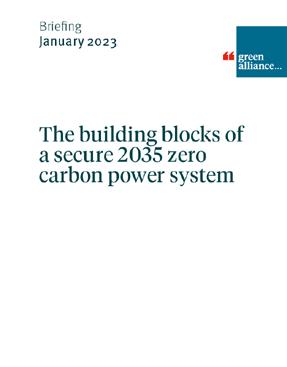
LOWER COST OF LIVING, STRONG ECONOMY
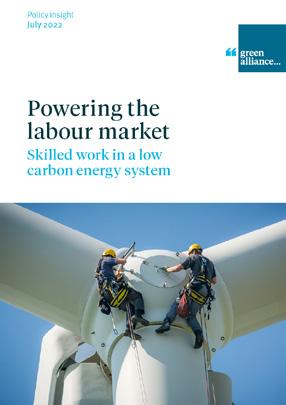



32







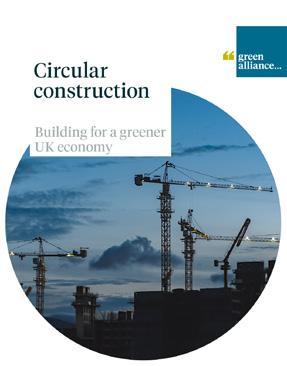


33


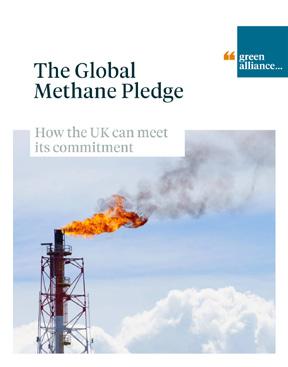

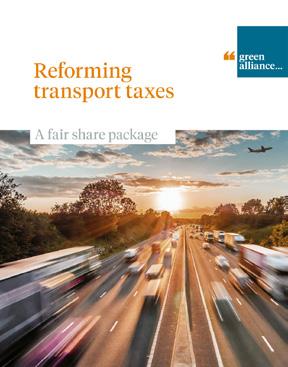
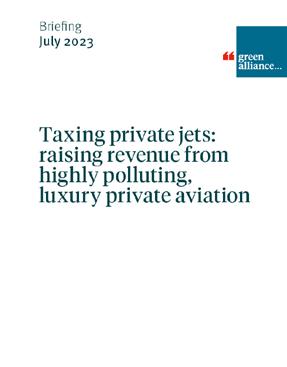









34 HEALTHY PLANET, HEALTHY PEOPLE Using resource efficiency to cut carbon and benefit the economy More out Less in





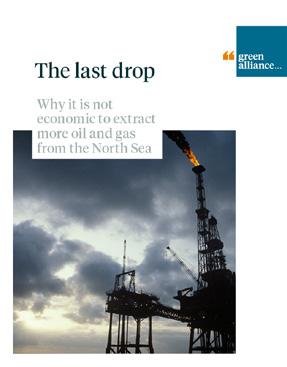








35 PROTECT THE UK’S FUTURE IN AN UNSTABLE WORLD
ENDNOTES
1 Energy and Climate Intelligence Unit, ‘Local elections poll: what voters thought about climate/net zero’, www. eciu.net
2 Green Alliance, Net zero policy tracker: June 2023 update
3 T Bell, et al., 13 July 2022, Stagnation nation, Resolution Foundation
4 Z Avison, November 2022, A green tax roadmap for the future, Green Alliance
5 SMMT, June 2023, Manifesto 2030 : automotive growth for a zero emission future
6 E McKelvie and H Bennett, 2023, Powering up the UK battery industry, Green Alliance
7 V Viisainen, et al, 2022, Building the future: a faster route to clean steel, Green Alliance
8 H Plumpton, August 2023, ‘Can renewable power help to tackle the UK’s inflation problem?’, Green Alliance briefing
9 S Dossett and L Hardy, January 2023, ‘The building blocks of a secure 2035 zero carbon power system’, Green Alliance briefing
10 S Alvis, et al, 2022, Powering the labour market: skilled work in a low carbon energy system, Green Alliance
11 S Dossett and L Hardy, January 2023, op cit
12 M Grubb and P Drummond, 2018, UK industrial electricity prices: competitiveness in a low carbon world, University College London
13 V Viisainen, et al, 2022, op cit
14 S Alvis, et al, 2022, Closing the UK’s green skills gap, Green Alliance
15 Ibid
16 F Wheeler, et al, 2023, The cluster effect: why the UK needs a place-based green industrial strategy, Green Alliance
17 Office for National Statistics (ONS), 10 May 2021, ‘Material footprint in the UK: 2018’
18 Z Avison and S Alvis, 2021, Levelling up through circular economy jobs, Green Alliance
19 WRAP, ‘Levelling up through a more circular economy’, www.wrap.org.uk
20 S Evans, et al, 2021, Critical point: securing the raw materials needed for the UK’s green transition, Green Alliance
21 J Dhaliwal, et al, 2023, Ready steady grow: how the Treasury can mainstream circular business, Green Alliance
22 S Evans and H Plumpton, 2022, Circular business: what companies need to make the switch, Green Alliance
23 C Brandmayr, et al, 2022, The bigger picture: addressing the UK’s hidden carbon footprint, Green Alliance
24 L Peake, et al, 2023, Circular construction: building for a greener UK economy, Green Alliance
25 Ibid
26 Arup and Ellen MacArthur Foundation, 2020, Realising the value of circular economy in real estate
27 H Dimbleby, 2023, Ravenous, Profile Books
28 J Elliott, et al, 2022, Land of opportunity: a new land use framework to restore nature and level up Britain, Green Alliance
29 L Collas and D Benton, 2023, Shaping UK land use: priorities for food, nature and climate, Green Alliance
30 Ibid
31 Wildlife and Country Link, 2023, 30x30 in England: 2023 progress report
32 Ibid
33 National Atmospheric Emissions Inventory (NAEI), 2020, ‘Emissions data selector’
34 L Hardy and D Benton, 2022, The Global Methane Pledge: how the UK can meet its commitment, Green Alliance
35 C Monteiro, et al, 2018, ‘Household availability of ultra-processed foods and obesity in nineteen European countries’, Public Health Nutrition, vol 21(1), pp 18-26
36 Insitute for Government (IfG), ‘Sugar tax’, www.instituteforgovernment.org.uk
37 C Witten, 2023, Appetite for change: why the UK should lead the emerging alternative proteins market, Green Alliance
38 WRAP, ‘Action on food waste’, www. wrap.org.uk
39 UNEP, March 2021, ‘Food Waste Index Report 2021’
40 Department for Environment, Food and Rural Affairs, 11 May 2022, impact assessment, ‘Food waste measurement and reporting for food businesses in England’
41 Ibid
42 J Burn-Murdoch, 21 July 2023, ‘What we get wrong when we talk about global warming’, Financial Times
43 New Economics Foundation, 5 November 2022, ‘Installing emergency insulation in draughty homes this winter would save families £260 a year, or £6.4bn for all households’, www.neweconomics.org
44 L Peake, et al, 2023, op cit
45 Z Avison, September 2022, ‘How street votes could help to protect the environment’, Green Alliance briefing
46 Climate Change Committee (CCC), 29 June 2022, 2022 progress report to parliament
47 H Bennett and C Brandmayr, 2021, Not going the extra mile, Green Alliance
48 The Guardian, 2022, ‘Dirty air affects 97% of UK homes, data shows’
49 Department for Transport, 2019, ‘National Travel Survey’
50 House of Commons Transport Committee, 2023, ‘Strategic road investment’
51 Transport for Quality of Life, 2018, The case for shifting road spending to sustainable travel
52 M Buchs and G Mattioli, October 2021, Trends in air travel inequality in the UK: from the few to the many?
53 CCC, 29 June 2022, op cit
54 R Allen, et al, 2023, Moving on: greener travel for the UK, Green Alliance
55 Sustrans, 2019, Common misconceptions of active travel investment
56 Transition Economics, 2020, ‘Can infrastructure stimulus replace UK jobs wiped out by COVID 19 crisis?’, analysis for the TUC
57 S Dossett and J Beckford, 2023, Reforming transport taxes: a fair share package, Green Alliance
58 H Bennett, July 2023, ‘Taxing private jets: raising revenue from highly polluting, luxury private aviation’, Green Alliance briefing
36
59 L Peake and T Booker, 2021, Targeting success Why the UK needs a new vision for resource use, Green Alliance
60 S Coulter, July 2023, ‘There are plenty of reasons why the UK needs a green industrial strategy’, Green Alliance ‘Inside Track’ blog
61 Greener UK, briefing, July 2021, ‘Environment Bill Committee briefing: Due diligence on forest risk commodities and global footprint’
62 Greener UK, briefing, July 2021, ‘Core standards explained’
63 Green Alliance, joint briefing with Friends of the Earth, Clean Trade and E3G, April 2023, ‘Leveraging trade policy and carbon border mechanisms to tackle consumption emissions and carbon leakage’
64 C Witten, February 2023, ‘The Energy Charter Treaty is a relic of the fossil fuel age, the UK should leave it’, Green Alliance ‘Inside Track’ blog
65 J Elliott, 2023, The case for a UK Office for Carbon Removal, Green Alliance
66 CCC, 24 February 2022, ‘Letter: Climate compatibility of new oil and gas fields’
67 H Plumpton, et al, 2022, The last drop: why it is not economic to extract more oil and gas from the North Sea, Green Alliance
37
Green Alliance
18th Floor Millbank Tower 21-24 Millbank London SW1P 4QP
020 7233 7433
ga@green-alliance.org.uk
www.green-alliance.org.uk
@GreenAllianceUK blog: www.greenallianceblog.org.uk
Green Alliance
Green Alliance is an independent think tank and charity focused on ambitious leadership for the environment. Since 1979, we have been working with the most influential leaders in business, NGOs and politics to accelerate political action and create transformative policy for a green and prosperous UK.
The Green Alliance Trust
Registered charity no 1045395 Company limited by guarantee (England and Wales) no. 3037633
Published by Green Alliance

ISBN 978-1-915754-19-6
Designed by Howdy
© Green Alliance, September 2023
Text and original graphics in this work are licensed under the terms of the Creative Commons Attribution License which permits unrestricted use, provided we are credited as the original author and source. Details of the license are available at: creativecommons.org/ licenses/by/4.0. Photographic images are subject to copyright and are not covered by this license.







 Photo by Dominik Pearce on Unsplash
Photo by Dominik Pearce on Unsplash




























































